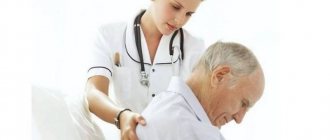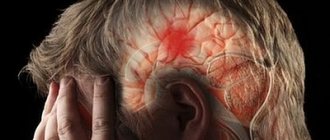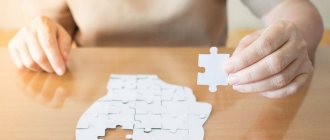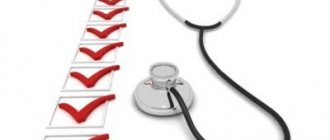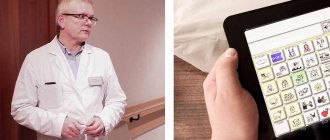Many of us have heard the name “ministroke,” but not everyone knows what it is and why this condition is dangerous.
To begin with, we note that, at the same time, it is necessary to distinguish between this condition and a stroke, and not.
Why?
- A disease that doesn't exist? Experts do not separately identify such a disease as microstroke. In the medical lexicon, this is called transient cerebrovascular accident (TCI);
- "Micro" disease? The prefix “micro” in the word is only misleading: it does not mean at all that there is no need to be afraid of this condition or that there is no need to take urgent measures to eliminate it; rather, on the contrary, it emphasizes the “kinship” with stroke with only one difference - in symptoms. The symptoms of a minor stroke are not as severe as those of a cerebral hemorrhage, and they go away much faster.
- Is it possible to recover? After a mini-stroke, the body can often recover without the help of a doctor, but it is still worth getting examined: even if the symptoms have already disappeared, the specialist should know that they were there. Thus, it is more likely that relapses and strokes will be prevented.
Causes of microstroke
Oddly enough, even young people (30-35 years old) are at risk for a mini-stroke. Experts attribute this to the environment, stress, and the presence of certain diseases.
The most common causes of microstroke are:
- Atherosclerosis is the formation of plaques on the inner surface of blood vessels. These same plaques can interfere with normal blood circulation;
- Congenital and acquired problems with blood vessels (varicose veins; thrombophlebitis; cerebrovascular crises);
- Diabetes mellitus, which thins the vascular wall;
- High blood pressure (BP);
- Previous heart attacks, arrhythmias and other heart diseases;
- Taking medications that increase the risk of thrombosis (for example, contraceptives);
- Vegetative-vascular dystonia (provokes circulatory disorders and pressure surges);
- Excess weight (the endocrine gland, which is adipose tissue, can produce an increased amount of estrogens, leading to the formation of blood clots);
- Excessive physical activity;
- Hereditary diseases that reduce the diameter of arteries, etc.
Increasingly, cases of illness transferred “on the legs” are being recorded. Since a mini-stroke does not have significant symptoms, often people busy with work or other activities do not pay due attention to the symptoms, do not consult a doctor in time, and simply continue to go about their business. This course of things can only aggravate the situation: in order to pass without complications, the disease must be diagnosed in time, and treatment must begin as soon as possible.
Expert opinion
Author: Tatyana Aleksandrovna Kosova
Head of the Department of Rehabilitation Medicine, neurologist, reflexologist
According to statistics, the number of cases of first-time transient cerebrovascular accident is increasing every year. A microstroke is provoked by various factors. It has been noted that the disease is most common among men of working age. According to clinical studies, in 10-15% of cases, myocardial infarction develops after a transient cerebrovascular accident. 30-40% of patients experience a major stroke over the next 5 years. Therefore, it is important to seek medical help on time and undergo preventive examinations.
Diagnosis of microstroke at the Yusupov Hospital is carried out using modern medical equipment. European CT and MRI installations make it possible to accurately determine the location of the lesion and its extent. An individual treatment and rehabilitation program is developed for each patient. The recovery period takes place under the supervision of experienced neurologists, massage therapists, exercise therapy instructors and physiotherapists. A personal approach can reduce the time of hospital stay and reduce the risk of recurrent microstroke.
Prohibited Products
Nutrition for a cerebral microstroke always requires giving up a certain list of foods. And the most interesting thing is that a person has to exclude from the menu the food that he loves most.
Prohibited products include the following:
- Fast food.
- Fatty dairy and meat products.
- Confectionery.
- Chocolate.
- Fried food.
- Mayonnaise, hot sauce.
- Smoked meats.
- Sausages.
- Canned food.
- Chicken egg yolks.
- Alcohol, strong tea and coffee.
It is also important to limit your salt intake. It is allowed to use no more than 3 g per day for cooking.
ATTENTION!!!
The patient must clearly understand that the use of these products is strictly prohibited, even if an irresistible desire arises. Otherwise, the body’s recovery will be slowed down, and the risk of recurrent mini-stroke will increase.
Symptoms of a microstroke
As already noted, a micro-stroke often hardly manifests itself: the symptoms are very mild, which is why they are so easy to overlook. But it’s still worth paying attention to these first signs of the disease:
- Numbness of the whole body (or one part of it, so it may be impossible to smile or raise both arms);
- Dizziness;
- Severe headache;
- Double vision;
- Unsteady movements, weakness, desire to sit down or lie down.
To diagnose a microstroke at home, you can use the FAST test. It was developed in America for emergency doctors so that they could easily diagnose cerebral hemorrhage. This test is also suitable for a micro-stroke, since the symptoms (facial distortion, weakened arms and incoherent speech) are also present in this case, although they pass much faster. FAST is an abbreviation, but the word itself is translated from English as “quickly” - one of the main rules when diagnosing a disease.
F (face - “face”) - you need to pay attention to the victim’s face: it can be unnaturally skewed.
A (arms - “hands”) - the patient’s hands do not obey: they are weakened, trembling and do not rise up.
S (speech - “speech”) - words are confused, it is impossible to pronounce even a simple sentence without errors.
T (time - “time”) - time: so precious in the case of this disease. It is better to start diagnostics as soon as the first signs appear, because as soon as they pass (with a microstroke this usually takes no more than an hour or two), the patient will feel great again. But for emergency doctors, diagnosing the symptoms will help a lot.
What is a microstroke
A microstroke differs from a regular stroke only in the extent of damage to brain cells. This is the same disruption of blood supply as a result of blockage of capillaries or small vessels. A microstroke can also occur with severe spasm of a bunch of small arteries and vessels. The main difference from a regular stroke is that after a mini-stroke a person recovers faster. Even a few minutes may pass, after which the patient will feel well and continue to carry out daily activities.
The main danger of a micro-stroke is that it can go unnoticed. Or, when the attack does not produce significant consequences, the patient decides not to waste time visiting the clinic and leaves the attack unattended, while at the first manifestations of the problem it is necessary to urgently seek advice from a specialist.
With a mini-stroke, brain tissue is affected that does not receive blood supply as a result of blockage of small arteries by a thrombus, blood clot, or due to spasm. Tissue necrosis affects a small area, which is why the patient does not show signs typical of an ischemic attack:
- difficulty lifting limbs;
- slurred speech;
- dizziness;
- severe headache.
If these signs appear, they disappear on their own after a short time. It may take no more than a day, and all body functions are restored again.
Rehabilitation after a mini-stroke
How to recover after a mini-stroke?
The following principles that patients adhere to contribute to rehabilitation and speedy recovery:
- A doctor is a specialist. And you need to trust specialists. If the patient is incompetent in matters of treatment and rehabilitation, it is worth following the doctor’s recommendations and taking the medications he prescribed;
- Don’t put it off until tomorrow... If a patient needs to do exercise therapy every day, this means that classes cannot be missed, otherwise the desired effect will not be achieved;
- The importance of support. After a ministroke or, worse, a stroke, the support of loved ones is very important for the patient. Sometimes they simply give up, patients become depressed, and only family and friends are able to influence and help a person they know well. You can accompany the patient to a massage or exercise therapy, help him prepare food so that it fits the diet, and just talk. Feelings of loneliness should not be present in rehabilitation.
- Systematicity. This means that if a patient is prescribed exercise therapy, he should not miss a single day; if he has a diet, then he needs to strictly follow it. In terms of timing, rehabilitation after a mini-stroke is an individual process, since everything depends on the degree of impairment and the patient’s condition.
- Gradualism. This means that the body does not recover immediately, it needs time. This means that it is better to leave the usual active workouts for later, and immediately after a micro-stroke go for a massage or exercise therapy.
Also, recovery and rehabilitation after a mini-stroke imply the following actions:
- Drug treatment
- Restoration of motor functions
- Vision restoration
- Restoration of speech function
- Normalization of psychological state
Drug treatment
Recovery of the body after a micro-stroke can occur on its own (this depends on the general health of the patient), but you still need to see a doctor: he will prescribe simple drug treatment, with the support of which the body will recover more quickly. But if the patient delays diagnosis and treatment, complications may arise. In this case, with a microstroke, the doctor prescribes the following groups of drugs responsible for restoring the body:
- improving blood microcirculation;
- improving metabolic processes in blood vessels;
- dilating vessels;
- preventing the formation of blood clots;
- stimulating brain activity;
- vitamins (to strengthen the immune system and improve brain activity).
Restoration of motor functions
A ministroke usually affects the lower and upper extremities, and motor function is impaired. The grasping reflex may disappear, weakness in the arms and legs may appear (symptoms may intensify and then it will be impossible to move at all).
The following methods are used to restore motor functions:
- Exercise therapy. Therapeutic exercise is designed to normalize muscle tone and restore strength to the muscles.
- Massage. This procedure relaxes, stimulates blood circulation and normalizes muscle tone. In this case, a massage session can be carried out both by a specialist and by the patient himself, if he is ready to strictly follow the doctor’s recommendations. You can also combine a procedure with a specialist and a home massage. This approach will speed up the recovery process.
- Physiotherapy. After a micro-stroke, the patient is usually prescribed warming, which allows the body to regain lost sensitivity.
Vision restoration
Frequent symptoms of a microstroke are double vision, darkening, spots, and even temporary blindness in one or two eyes at once. While the patient is undergoing treatment, the issue of vision restoration is dealt with by an ophthalmologist, and less often by a surgeon (if it is impossible to avoid surgical intervention). During the rehabilitation period, the patient is usually prescribed pills that normalize vision function, and is also recommended to perform special exercises that stimulate the work of the oculomotor nerve. To record progress or regression, it is recommended to visit a doctor regularly.
Restoration of speech function
Confusion of speech is another symptom of a mini-stroke, which can be cured with proper treatment. But, if after treatment the speech function is not completely restored, special classes are conducted with the patient aimed at its restoration. They are usually carried out by a speech therapist or neuropsychologist. In case of complications and serious speech disorders, all basic speech skills are studied with the patient from scratch: listening (understanding what is heard), reading, writing, speaking.
The process of speech restoration will accelerate if the patient’s relatives continue to study with him at home. For the process to be effective, in addition to training with the victim, you just need to talk (ask him simple questions, patiently waiting for an answer; tell the news; share opinions, etc.), even if this seems useless at first glance. But we must remember that a person can only speak in a linguistic environment (that is, he must constantly hear speech in order to begin to produce it), which is the task of family and friends to create during the rehabilitation period.
Normalization of psychological state
Patients who have suffered a mini-stroke often experience depression (people with a fine mental organization and women are especially prone to it due to their physiology and psyche). Relatives need to try to understand this condition: the patient suddenly lost some abilities, is forced to take pills and regularly visit the doctor. His life has completely changed. To help him overcome this condition it is necessary:
- Interact and communicate with him more often;
- Go for walks, which will provide him with physical activity;
- Help you find a new hobby or return to an old one, if possible.
As soon as rehabilitation is over, it is better for a person to return to work: to the old one or, if this is not possible, to find a new one as soon as possible.
Any activity requires a certain amount of effort and time, therefore, by getting busy, the patient will think less about problems and, accordingly, will quickly overcome a depressive state.
Where and how to undergo rehabilitation and how long will it take to recover after a mini-stroke? These are the most frequently asked questions by patients. Of course, everyone wants to return to normal life as soon as possible, go to work or go on a trip.
Rehabilitation is possible both at home and in a hospital setting. In the first case, success will depend on those who surround the patient: on their willingness to communicate, care and support. Secondly, it depends on the literacy of specialists and the development of the rehabilitation program.
The Yusupov Hospital, for example, has its own rehabilitation center, where the patient will be under the supervision of competent specialists who will go through all the rehabilitation activities with him from start to finish. Rehabilitation after a mini-stroke in the clinic is carried out according to an individual program, depending on the severity of the disorders in each individual patient.
But how long does it take to recover from a mini-stroke? Unfortunately, these are individual indicators. They depend on the general condition of the patient, whether there are complications or not, and on the approach to rehabilitation. With the correct approach of the patient to treatment and rehabilitation, usually all functions are restored within six months.
Symptoms and main signs
All possible symptoms of a microstroke are usually divided into two large categories: focal and cerebral. In the first case, the normal blood circulation of only certain parts of the brain is disrupted, so by what functions are affected, one can understand which area of the brain has undergone an attack. The following symptoms are possible:
- Numbness and paralysis of various limbs;
- Sudden vision problems, most often localized in the direction where the attack occurred;
- Problems with movement, loss of normal muscle tone;
- Impaired memory and thought processes;
- Speech problems;
- Problems with swallowing, etc.
As for cerebral symptoms, they look like this:
- Sudden onset of headaches, dizziness;
- Problems with coordination;
- Weakness in arms, legs;
- Fainting and clouding of consciousness;
- It becomes difficult to breathe, the patient complains of a “lump” in the throat;
- Attacks of nausea and vomiting;
- Painful sensitivity to light, noise.
If such phenomena occur, it is imperative to call an ambulance.
Forecast of microstroke
A microstroke is not the most terrible disease, it is only the first warning sign before a stroke (according to statistics, it occurs in 60% of cases after a microstroke), an opportunity for a person to change something in his life and pay special attention to health. If you follow the doctor’s advice and undergo rehabilitation in full, the consequences of a micro-stroke will be invisible (slight muscle weakness, fatigue, dizziness with a sudden change in body position, etc.) or will disappear altogether. If the patient does not pay due attention to his body, the likelihood of a relapse or even a stroke arises several times, which is already much more dangerous in its consequences, including:
- Men at a young age experience memory impairment, erectile dysfunction, frequent headaches, seizures, mood swings, and paresis. Women have similar functions to men, with one difference: the more frequent occurrence of depressive conditions. This is due to the characteristics of female physiology and psyche.
- Elderly people experience difficulty in motor activity, decreased vision, decreased memory and mental activity, speech impairment, sclerosis, and paresis.
To avoid negative consequences, it is better to diagnose any disease and begin treatment as soon as possible, and a microstroke, despite its prefix “micro,” is no exception.
Symptoms, first aid and treatment of microstroke
A microstroke is called necrosis of brain tissue, which occurs due to a blood clot or ischemic narrowing (sharp) of a small vessel. In the condition under consideration, necrotic changes in brain tissue are minimal, but they are still present, and there is no absolutely complete reversibility. In order to recover quickly, you need to know the symptoms and principles of treating a microstroke - timely and competent medical care can literally save the patient’s life. In addition, such ischemic “attacks” on small blood vessels have a destructive effect on the optic nerves - the patient’s vision can be significantly reduced; doctors call this condition a microstroke of the eye. According to statistics, a sharp narrowing of small vessels in the brain often occurs in people 35 years of age and older, but micro-stroke also occurs at an early age.
Prevention
Prevention is a rewarding endeavor, because any disease is easier to prevent than to treat. And the preventive measures for most diseases are the same, so if you follow simple rules, you can avoid many diseases.
What should be done?
- Maintain normal blood pressure. A microstroke occurs most often due to a sharp rise in pressure. Buy a tonometer: now these devices are small and convenient (so you can even take it with you on a trip) and measure your pressure at least once a day;
- To refuse from bad habits. And these are not just words: alcohol and coffee, for example, also provoke pressure surges, and smoking thins blood vessels;
- Dieting. A diet for the prevention of micro-stroke involves avoiding fatty, fried foods: it is important to prevent the formation of cholesterol plaques;
- Regular exercise. It is not at all necessary to run a marathon, but walking in the park every day for 40-60 minutes is advisable;
- Healthy sleep, avoiding stressful situations. Lack of normal sleep and stress can also lead to a jump in blood pressure;
- Prevention and timely treatment of vascular diseases and diabetes. These diseases provoke strokes and heart attacks, so it is better to get rid of them as soon as possible.
A microstroke is not the most terrible disease, but it can still become one without proper help. If a minor stroke develops into a traditional one, the consequences can be dire: disability or even death is not uncommon. Therefore, any disease, even a minor one in your opinion, is best treated without delay.
First aid for microstroke
If a person has a mini-stroke, then you need to immediately call an ambulance, and while it is on the way, take the following measures:
- Place the patient on a flat plane, raise the head slightly above the body and turn to the side;
- Loosen the straps, unfasten the buttons;
- Open the windows in the room;
- If possible, eliminate noise and other irritants;
- You cannot let a person panic, so it is necessary to have calming conversations with him;
- If necessary, cardiac massage and artificial respiration are performed.
You cannot give a person with an attack medications that affect the condition of blood vessels, blood pressure, slow him down, or allow him to get up.

